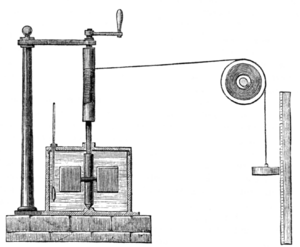Work (thermodynamics) facts for kids
Work transfer in thermodynamics is a way energy moves from one place to another. It happens when a force pushes or pulls something over a distance. Think of it like lifting a box or pushing a cart. When you do this, you are doing work, and energy is being transferred. We measure work in units called Joules.
Work transfer is different from heat transfer because it doesn't directly involve changes in temperature. Instead, it's about the bigger, more noticeable changes in a system, like its volume or position.
Contents
How We Learned About Work
Early Ideas (1824)
The idea of "work" was first explained clearly in 1824 by a French scientist named Nicolas Léonard Sadi Carnot. He wrote about it in his famous paper, Reflections on the Motive Power of Fire.
Carnot said that when an engine does something useful, it's like lifting a weight to a certain height. He explained that you could measure this "motive power" (which we now call work) by multiplying the weight by how high it was lifted.
We use here motive power (work) to express the useful effect that a motor is capable of producing. This effect can always be likened to the elevation of a weight to a certain height. It has, as we know, as a measure, the product of the weight multiplied by the height to which it is raised.
Joule's Experiment (1845)
Later, in 1845, an English physicist named James Prescott Joule did a very important experiment. He wanted to show how work and heat were connected.
Joule built a special device where a falling weight turned a paddle-wheel inside a barrel of water. As the weight fell, it did work on the paddle-wheel. The paddle-wheel then stirred the water, causing friction. This friction made the water get warmer.
Joule carefully measured how much the water's temperature increased and how far the weight fell. From these measurements, he figured out how much mechanical work was equal to a certain amount of heat. This experiment helped scientists understand the links between heat, work, temperature, and energy.
What is Thermodynamic Work?
In thermodynamics, which is the study of heat and energy, it's helpful to think of energy changes in two main ways: work and heat.
Work is when energy moves because of changes we can easily see or measure in a system. For example, if a gas expands and pushes a piston out of a cylinder, that's work being done. The gas is pushing against an outside force.
This is different from heat energy, which is about the tiny, invisible movements of particles inside a system. Heat is transferred when these tiny particles bump into each other and pass on their energy.
Thermodynamic work is a bit broader than just physical pushing or pulling. It can also include things like:
- Electrical work: Moving an electric charge against an electric field.
- Chemical work: Energy involved in chemical reactions.
So, thermodynamic work doesn't always have to involve something moving in a mechanical way. It's any energy transfer that isn't directly related to temperature differences.
Related pages
See also
 In Spanish: Trabajo (termodinámica) para niños
In Spanish: Trabajo (termodinámica) para niños


